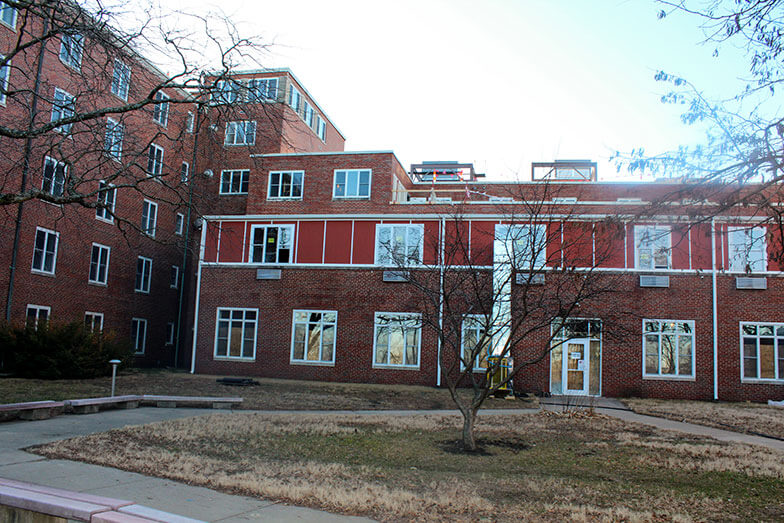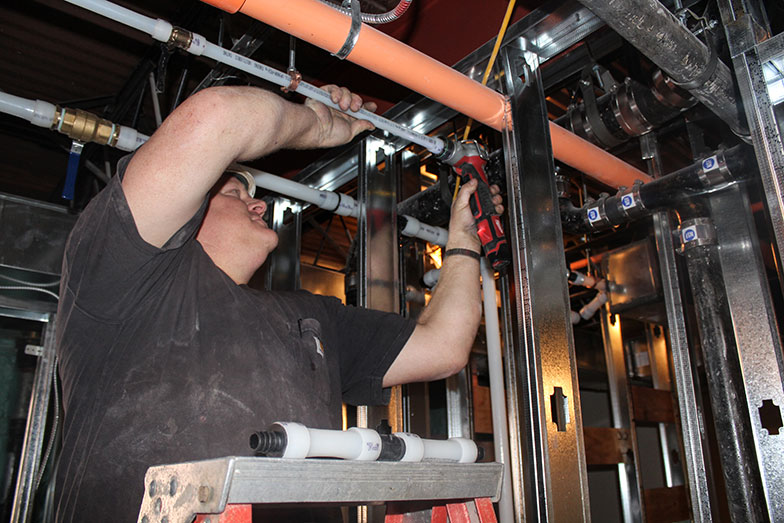
Saladino Mechanical of Kansas City, MO, won the bid for a college dorm renovation by specifying Uponor’s PEX piping rather than more costly copper—a move that saved the contractor time and money during installation. The dorm’s new plumbing system is also more efficient, saving energy and conserving water. Uponor is a sponsor of MCAA’s 2021 Virtual Education Conference.
Updates Needed
CollegeProwler.com, a university search site for students by students that ranks everything from parking, transportation, and housing to campus life, academics, and athletics, gave a very astute observation of Kansas University’s Gertrude Sellards Pearson (GSP) Hall: “Great location, but needs renovation.” The university heard the call loud and clear and set out to accomplish a year-long, $13-million renovation that included a complete interior demolition of the electrical, plumbing, and HVAC systems.
Built in 1955, the four-story, 109,000-square-foot building was initially plumbed with galvanized steel and then re-piped with copper in the late 1990s. When bids went out for the new renovation, all the plumbing bids with copper came in too high.
PEX Piping Prevails
Saladino decided to rebid the project with PEX—a flexible, durable, polymer piping product that has been gaining popularity in commercial plumbing projects over the past decade because of its extreme durability and cost-effectiveness. While PEX has a 40-year history in residential projects (in fact, it is installed in more new-home plumbing construction than copper and CPVC combined), builders have been slower to adopt the product for commercial projects because of concerns that a “plastic” product is not as durable as metal.
However, thanks to its corrosion resistance and extreme flexibility, PEX is more durable than metal, which can corrode, and it is faster and easier to install. Because PEX is not a traded commodity that fluctuates in price, like copper, contractors can bid a project with greater confidence.
Carl Bachner, foreman at Saladino, has been plumbing with PEX since 2003 and was very familiar with the product. He worked with Mark Baker of Uponor representative firm Specified Systems, Inc., to send the project through Uponor Construction Services for the design work. The bid came back right on target.
“I was first introduced to PEX back in 2003 when I was installing the plumbing system for an assisted living complex,” said Bachner. “After that, I installed it in my own home, and I’ve never had a problem with it.”
Cutting Down Costs
The GSP Hall re-pipe used nearly 12,000′ of 1/2″, 3/4″, 1″, 1-1/4″, 1-1/2″, and 2″ Uponor AquaPEX® for the plumbing system, which included piping for 42 bathrooms, a laundry facility, and a large kitchen to accommodate more than 300 students.
The system also included Uponor’s ProPEX® engineered polymer (EP) and lead-free brass fittings. Baker noted that using EP fittings also helped bring the costs down for the plumbing system.
“The EP product is helping us get a good leg up on the competition cost-wise compared to brass,” said Baker. “In fact, up to 80 percent of the fittings we do now are EP.”
The cold-expansion ProPEX fitting concept was also a big winner with Bachner and the other installers. The ProPEX connection uses an expansion tool to expand the flexible PEX pipe to insert a fitting. Then, as the PEX shrinks back to its original size, it creates a solid, strong connection around the fitting.
“The ProPEX fitting is nice because it doesn’t restrict the flow like insert fittings do,” remarked Bachner. “It keeps the same OD [outside diameter] like copper does.”
Other Advantages Achieved
The new plumbing system included multiport tees in the bathrooms to supply water to the lavatories and showers. A multiport tee is essentially one long tee with multiple outlets. This product reduces the number of required connections in a system for faster, easier installation while improving system performance by distributing water to fixtures in a single grouping.
This installation method, known as “logic” plumbing, also provides advantages for clustered or consecutive uses of hot water, saving on energy and water usage. Once hot water arrives at a multiport, it is readily available to all fixtures connected to it. Essentially, that multiport’s fixture grouping is “charged” with hot water.
Energy and water conservation were also a large part of the design process, which included several runs of preinsulated Uponor AquaPEX pipe to insulate the hot-water lines. The preinsulated piping product is available with insulation sizes from 1/2″ up to 1-1/2″ to help projects meet energy codes while offering installers a preinsulated product, which saves time.
The design also called for a unique application for the flush-valve water closets. The designers came up with a concept that used PEX along with prefabricated stubouts instead of traditional copper or another rigid piping product. This approach helped save on costs when compared with using only copper.
Because of its flexibility, PEX significantly dampens surge pressure and noise transmission when compared with copper. Surge pressure in PEX is 65 percent less than in copper, and noise transmission in copper is eight times higher than in PEX. For these reasons, using PEX for all the flush-valve water closets worked well. The project used prefabricated 18″ by 6″ stubouts of 1″ copper that were rigidly supported behind the wall to transition from PEX to the flush valve.

After his experience with the GSP Hall re-pipe project, Bachner was very happy with the results. Not only did his installers work faster with flexible PEX compared with rigid copper, but using PEX helped his bottom line as well. With the stable pricing of cost-effective PEX and EP fittings, Saladino kept costs low and the project on budget.
For more information, visit www.uponor-usa.com.
MCAA thanks Uponor for being a sponsor of MCAA’s 2021 Virtual Education Conference.


